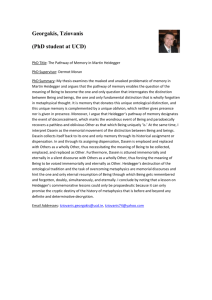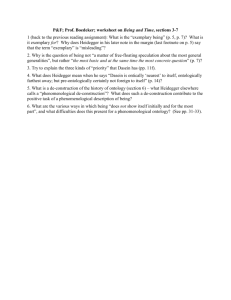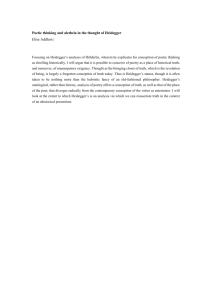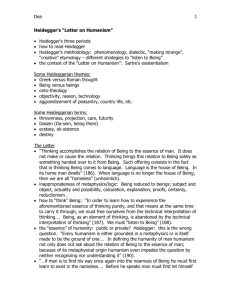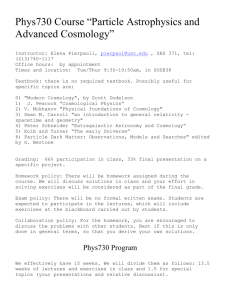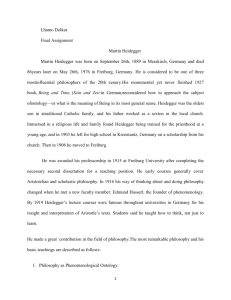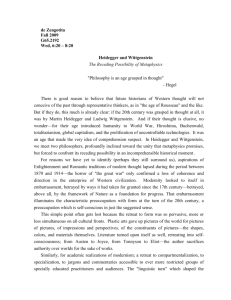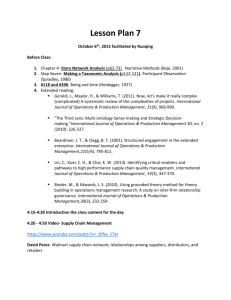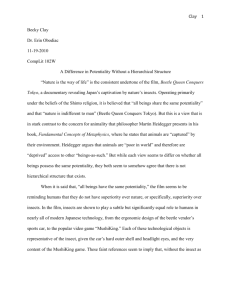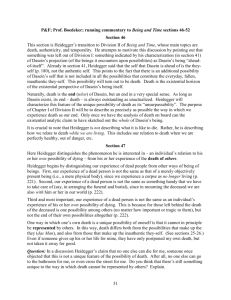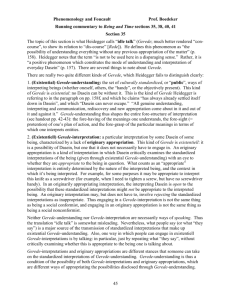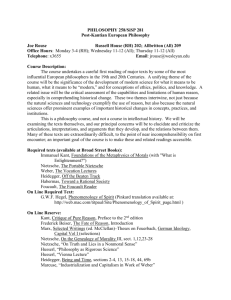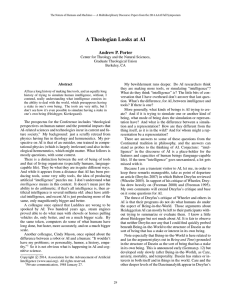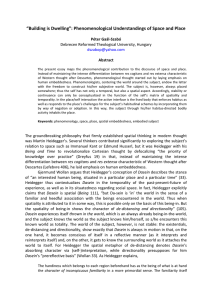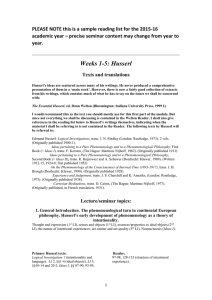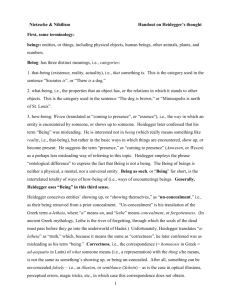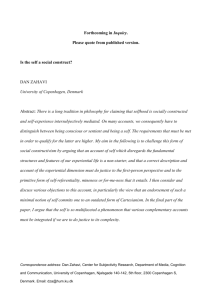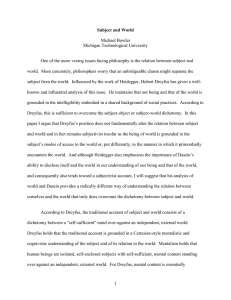Hans Ulrich Gumbrecht: Production of Presence. What Meaning
advertisement
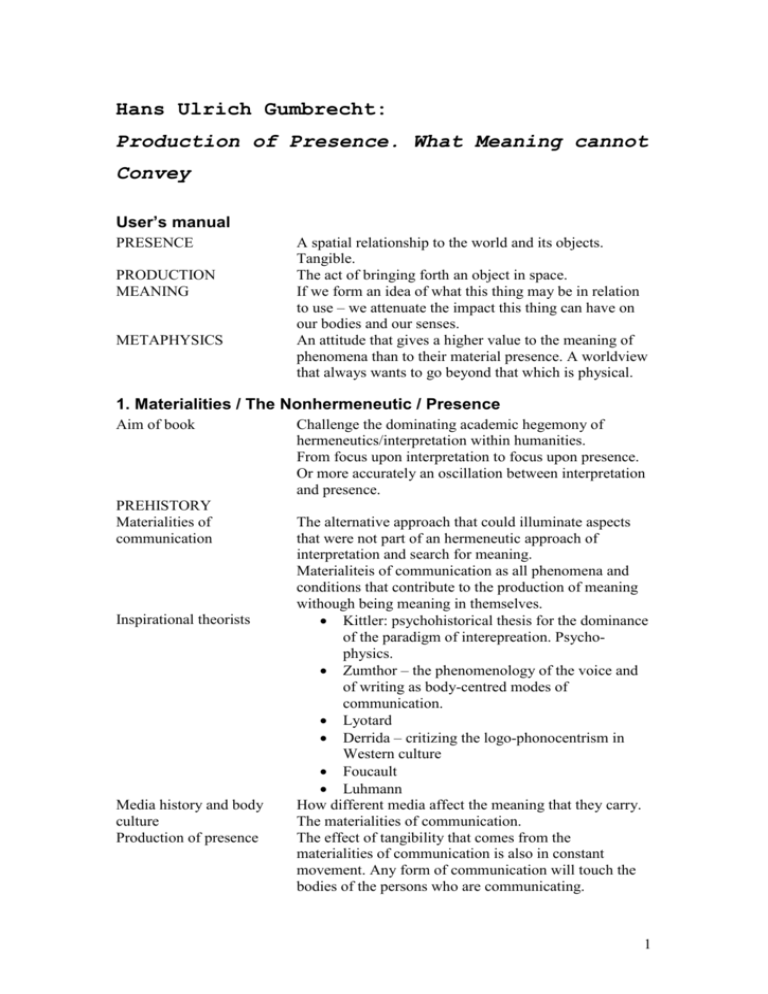
Hans Ulrich Gumbrecht: Production of Presence. What Meaning cannot Convey User’s manual PRESENCE PRODUCTION MEANING METAPHYSICS A spatial relationship to the world and its objects. Tangible. The act of bringing forth an object in space. If we form an idea of what this thing may be in relation to use – we attenuate the impact this thing can have on our bodies and our senses. An attitude that gives a higher value to the meaning of phenomena than to their material presence. A worldview that always wants to go beyond that which is physical. 1. Materialities / The Nonhermeneutic / Presence Aim of book PREHISTORY Materialities of communication Inspirational theorists Media history and body culture Production of presence Challenge the dominating academic hegemony of hermeneutics/interpretation within humanities. From focus upon interpretation to focus upon presence. Or more accurately an oscillation between interpretation and presence. The alternative approach that could illuminate aspects that were not part of an hermeneutic approach of interpretation and search for meaning. Materialiteis of communication as all phenomena and conditions that contribute to the production of meaning withough being meaning in themselves. Kittler: psychohistorical thesis for the dominance of the paradigm of interepreation. Psychophysics. Zumthor – the phenomenology of the voice and of writing as body-centred modes of communication. Lyotard Derrida – critizing the logo-phonocentrism in Western culture Foucault Luhmann How different media affect the meaning that they carry. The materialities of communication. The effect of tangibility that comes from the materialities of communication is also in constant movement. Any form of communication will touch the bodies of the persons who are communicating. 1 3. Beyong Meaning: Positions and Concepts in Motion Beyond metaphysics Daring to be substantialistic Hermeneutic maximalism Gumbrecht’s wish Jean-Luc Nancy on presence Bohrer on suddenness George Steiner on real presence Critique against “constructivism” Judith Butler Michael Taussig Martin Seel Hans-Georg Gadamer Heidegger moves beyond meaning Doing something in addition to interpretation. There is more to the world than meaning. The Cartesian worldview and hermeneutics make it difficult to se what this could be. Concept such as “substance,” “presence,” “reality,” “being.” e.g. Gianni Vattimo/ Interpretation held to be humankind’s exclusive way of relating to the world. Try to reestablish our contact with the things of the world outside the subject/object paradigm and by avoiding interpretation. The subject/object paradigm excludes any easy world-reference. Alludes to a conception of presence that is difficult to reconcile with modern Western epistemology <-- brings back physical closeness and tangibility. Connects presence with extreme temporality: presence is not something that we can hold on to. The ephemeral character of aesthetic experience. “the negativity of the awareness of vanishing presence.” Substance, not meaning: the substance of the signifier. The relationship of layers of meaning and layers of substantive presence in art. Meaningfulness, not meaning. Substance and immanence. Realities as constructions of our consciousness, still with features of consciousness that are common among all humans (the transcendenal subject). Shared realities are social constructions. The materiality of the body and the fixity and stability this materiality causes. Change requires forms of behaviour and action maintained over time (not a simple decision to change as constructivism seems to suggest). Continues the polemic against constructivism.”If life is constructed, how come it appears to ummutable? How come culture appears so natural?” (62). The true real of substance and materiality New reflection on aesthetics in the concept of “appearance:” the conditions through which the world is given to use and presents itself to the human senses. Wahrnehmung. Bring back the thingness of the world. The father of hermeneutics. Suggested a greater acknowledgment f the nonsemantic, i.e, material components. Actually produced a repertoire of nonmetaphysical concepts. Discontenet witht the philosophy of Husserl: Husserl’s phenomenology was the endpoint of a philosophical tradition in which the subject/object paradigm had led the Western culture to an extreme state of alienation from the world (human existence as purely 2 spiritual, and the world as purely material sphere). Heidegger’s decisive The characterizatoin of human existence as being-in-theconceptual move world – an existence that is already substantial and in spatial contact with the world. “Being” Obviously of relevance in a discussion of presence. 1. Being takes over the The place of the truth had been occupied by the “ideas” place of truth or other forms of conceptual configurations. Being is not something conceptual. Being belongs to the dimension of things. It has substance and it occupies space. 2. Being’s movement in Accounts for what Heidegger calls the “happening of space is multidimensional truth.” The three directions in the movement of Being: vertical (sway), horizontal (idea, look), withdrawal. The vertical dimension points to Being simply being there. The horizontal dimension points to Being as being perceived. Being refers to the things of the world prior to their interpretation. The double movement of Being refers to things before they become part of a “unconcealment” and culture. Being only as Being outside of the networks of “withdrawal” semantics. But for us to experience Being, it will have to cross over and become part of culture. And is no longer Being. 3. The role of Dasein in Dasein is not like subjectivity. Dasein is being-in-thethe happening of truth world, human existence that is always already in contact with the world. Does not concern manipulating, transforming, or interpreting the world. 4. Heidegger’s tendency to The unconcealment (and the withdrawal) of Being. The present the work of art as happening of truth as making us see things in a way a priviliged site for the “different from the ordinary way.” happening of truth Paralleling with world and “The world is the self-disclosing openness of the broad earth paths of the simple and essential decisions in the destiny of a historical people. The earth is the spontaneous forthcoming of that which is continually self-secluding and to that extent sheltering and concealing.” (73). Being and presence Are obviously very close. Both imply substance, both are related to space, both can be associated with movement. The tension between meaning (that which makes things culturally specific) and presence or Being. MEDIEVAL CULTURE Turning to pre- or nonmetaphysical cultures and discourses. Propose concepts that can help overcome the status of interpretation within the humanities. Two typologies, which are to be understood as Ideal-typen. 1. propose a distinction None of which have existed in a pure form. between “meaning Still some cultural phenomena are more the the presence culture” and “presence culture side (e.g. the sacraments of the Catholic Church), culture” others are more on the meaning side (the early modern Spanish Empire). 1. The mind vs. the body The mind is the dominant human self-reference in a meaning culture; the body is dominating in a presence culture. 3 2. Subjectivity vs. “Subjectivity” within meaning cultures – eccentric in cosmology relation to the world. In presence cultures, humans consider their bodies to be part of a cosmology – part of the world. 3. Legitimate knowledge Meaning culture: if it has been produced by a subject in an act of world-interpretation. Presence culture: legitimate knowledge is revealed knowledge. Revelation and unconcealment. Not necessarily conceptual, can be substantial 4. What is a sign Meaning culture: Saussure – the coupling of a material signifier with a purely spiritual signified (or “meaning”). When the meaning is identified, the material signifier ceases to an object of interest. 5. Humans in the world 6. Space/Time 7. Violence and power 8. Innovation 9. Playfulness Presence culture: an understanding of the sign that is close to the Aristotelian sign defininition. A sign is a coupling between a substance (requires space) and a form (makes it possible for the substance to be perceived). The spiritual and the material is brought together in the sign – no side of the sign-concept will vanish once a meaning is secured. Meaning culture: transforming the world is the main vocation of the human. Presence culture: where humans want to relate to the surrounding cosmology by inscribing (their bodies) themselves into the rhythms of the cosmology. No will to alter these rhythms. Meaning culture: Time is the primordial dimension – an unavoidable association beteen consciousness and temporality (Husserl: Stream of consciousness). Presence culture: Space is the primordial dimension in which the relationship between humans and the things of the world are being negotiated. Meaning culture: Typical to defer the moment of actual violence and thus transform violence into power. Presence culture: The relationship between human bodies can constantly turn into violence. Meaning culture: The concept of event is inseparably linked to the value of innovation. Presence culture: The equivalent of an innovation is the departure from the regularities of a cosmology and its codes for human conduct. Meaning culture: Playfulness and fiction as concepts that characterize interactions whose participants have limited or no awareness at the motivations that guide their behaviour. Presence culture: Actions (as motivation for behaviour) have no place – thus cannot produce an equivalent f the concepts of playfulness or fiction. 4 10. Meaning cultures: parliamentary discussions. Presence culture: Eucharist as the prototypical ritual. Makes God’s body physically present as the central part of a past situation. Types of worldFour types: eating, penetrating, mysticism, appropriation interpretation/communication 1. Eating the things of the As in eating the body and drinking the blood of Christ. world The most direct way of becoming one with the things of the world in their tangible presence. 2. Penetrating things and Body contact, sexuality, aggression, destruction. The bodies merging of bodies with other bodies. 3. Mysticism The presence of the world or the other is physically felt although there is no perception of a real object. In meaning cultures – the fear of loosing control over oneself. 4. Communication and As exclusively spiritual ways of world-appropriation interpretation correspond to meaning-culture. Fear of total communication: of being accessible in one’s innermost thoughts and feelings. 5
